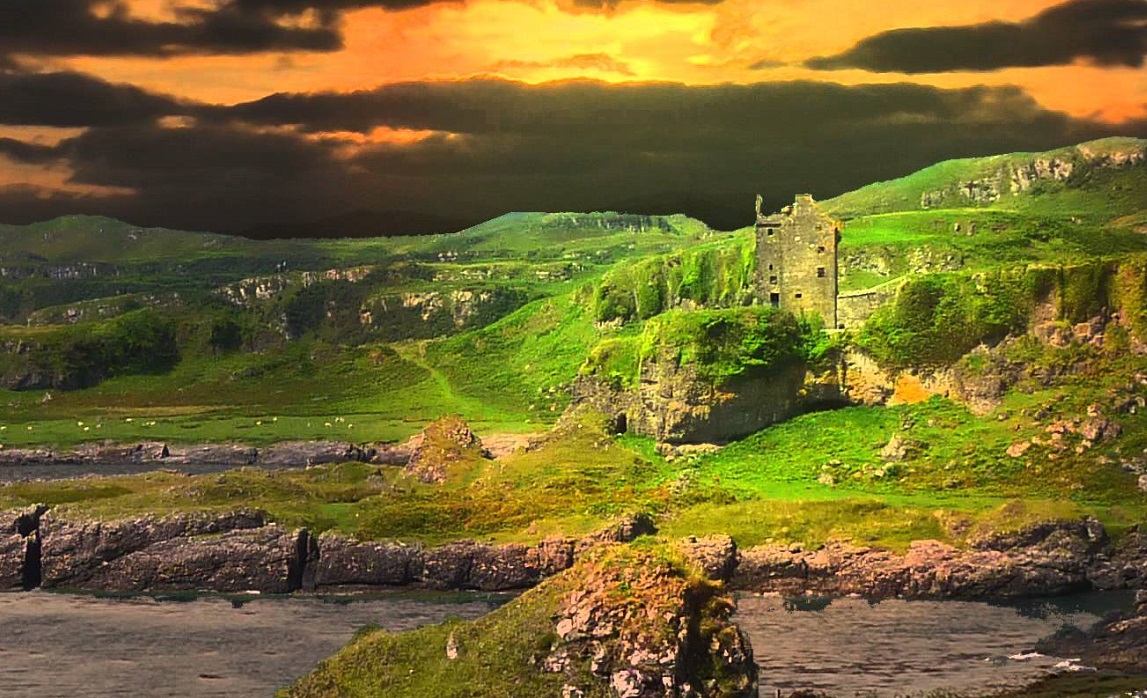Clan warfare, kings, battles, castles and walks
wee tip for a superb day out on Scotland’s west coast, get yourseles to Oban – or, use as a part of your tour and stay a few days/one day – pick the best weather – enjoy a back in time experience.
The northern end of Kerrera looks across at Oban Bay towards Oban. To get to Kerrera you travel a mile or so past the ferry and around the corner to Gallanach. The small ferry there takes you across a wee strip of water: Kerrera is a has approx 34 residents. The only vehicles on the island are those owned by islanders, but as the walk to the south end of the island is only six miles in length, that is not bad. The best way to enjoy the island is to take the circular walk of southern Kerrera. Clockwise, you come to Horseshoe Bay, better known as where King Alexander II died, on 8 July 1249. He was there with a large fleet in Oban Bay to try to retake Western Scotland from the Norse when he fell ill, he died at Horseshoe Bay. At the southern end you see a path to Gylen Castle, a ten minute walk to the castle (20 minutes if you are me), the path takes you past a beach and up a hill to the castle/tower house, built in 1587. This strong building did the MacDougalls nae good when it was besieged and burned by Major-General Leslie’s Covenanter Army during the Wars of the Covenant in 1647. All those sheltering in the castle were killed during the attack or after surrendering, typical clan warfare.
The views west to Mull and north along the length of Kerrera are truly magnificent. In the 16 century this was one of the busiest shipping routes in/out of the Inner Hebrides. Duncan MacDougall of Dunollie (not friendly to the maacleans by the way) built it. Friend of the dreaded Campbells. A four storey ‘L’ plan Tower built in Scots Baronial style and had a natural spring that provided water. The MacDougalls still owned the castle in the mid-seventeenth century. The clan supported of the Royalist cause and in 1647 a detachment of Covenanters, the castle, the clansmen in the castle surrendered and all massacred except John MacDougall who was spared on the grounds he was just a child. Gylen was burnt. It has remained a ruin ever since. The ruins became famous after being painted by the artist J.W.M Turner in 1831.
A wee history lesson; The MacDougall’s fell into conflict with the Campbells. In 1294 John MacDougall of Argyll led the Clan MacDougall against the Campbells at the Battle of Red Ford, where Sir Colin Campbell was killed but there were considerable losses on both sides. The 4th chief of MacDougall married a sister of John II Comyn, Lord of Badenoch (the “Black Comyn”), whose son, John III Comyn, Lord of Badenoch (the “Red Comyn”) was stabbed to death by Robert the Bruce in the church of Greyfriars in Dumfries in 1306, and this sent the MacDougalls into conflict with the Bruces. Shortly after Robert the Bruce’s coronation at Scone he was forced by the English to retreat into Argyll, in an attempt to reach his Clan Campbell allies (at the time). The MacDougall surprised the Bruce and defeated him in what was known as the Battle of Dalrigh (you may pass this on the way in/out of Oban). Three years later the Bruce led three thousand veterans into Argyll against the MacDougalls. John MacDougall of Lorne set an ambush for them but in the ensuing Battle of the Pass of Brander (near Loch Awe) the MacDougalls were defeated and fled. The MacDougalls’ lands were then forfeited by the king and he gave them to the Campbells for their loyalty. By the way, this is how the Campbells got much of their land and power. Most of their mainland lands were returned in a royal charter from David II of Scotland. Although the lordship of Lorne eventually passed into the hands of the Stewarts following John Gallda’s death, the MacDougall chiefly line preserved through his son Allan. Gylen Castle, is still owned by the MacDougalls. Dunstaffnage Castle, three and a half miles north-east of Oban, is a large courtyard castle with a high curtain wall. The kings of Dál Riata (that’s another story) also had a strong hold there. The Stone of Scone (Stone of Destiny) is said to have been kept at the castle. The present castle was built by the MacDougalls and was besieged by Robert the Bruce after the MacDougalls were defeated at the Battle of the Pass of Brander in 1309. The Bruce then made it a royal castle with the Campbells as the keepers. castle is now in the care of Historic Scotland. Duart Castle, on Mull. The castle was possibly built by the MacDougalls in the 13th century, and came into the possession of the MacLeans in the fourteenth century. With a brief “steal” by the dreaded Campbells it is now firmly back in Maclean hands – another long story, but – we can take you there to meet the Chief, well known to us!
Ask for tour details; info@mcleanscotland.com

